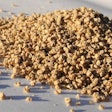Estimates compiled by our associated publication Feed International suggest that world compound feed production for all species by industrial feed mills in 2010 increased by about 1.4%, to a new record of approximately 718 million metric tons with a combined market value of about $240 billion. Further growth in 2011 has been constrained primarily by high feed grain prices globally, although Asian countries have continued to deliver extra volumes to meet local requirements.
In most years, the industrial manufacturing of feeds for poultry represents between 40% and 45% of total compound feed production worldwide. Within the category of poultry feeds, output tends to be divided almost equally between products for feeding to meat birds and diets for egg layers.
Poultry represents the largest single segment of compound feed production by industrial mills on a global basis, compared with approximate shares of 30% for pigs, 25% for ruminants and less than 5% for aquaculture. The variation between Asian countries for the proportion of poultry feeds in total feed production is illustrated in chart 1.
A significant event in 2011 was the announcement by the European Feed Manufacturers’ Federation, FEFAC, that its calculations showed poultry feeds have become the biggest part of the industrial feed market in the European Union, taking the number one slot from pig feeds for the first time. According to FEFAC figures prepared for its latest annual congress, EU countries produced a total of 149.97 million metric tons of compound feeds at industrial mills in 2010. Feeds for poultry registered 50.89 million tons, whereas pig feed recorded 49.65 million tons.
FEFAC’s first projections for 2011 were that the poultry feed tonnage would rise by about 0.5%, with cattle feeds up 2% and a 1.5% drop in pig feed volume.
Shares grow in key markets
Brazil’s national association Sindicato Nacional da Indústria de Alimentação Animal, Sindirações, estimated that the Brazilian production of slightly more than 60 million metric tons of all compound feeds includes nearly 34 million tons for the poultry sector, a share of 57%. The fact that about 80% of the feeds made industrially in Indonesia are for poultry has helped bring the national feed industry to an annual growth rate of 4%.
A big increase in Russia’s poultry feed production has been projected by Russian government officials. In a draft program on the development of feed production, they projected poultry’s share of compound feed consumption to grow from 31% in 2009, to 34% in 2012. A U.S. Department of Agriculture report estimated that poultry establishments in Russia currently manufacture about 70% of the country’s total feed requirements.
Increases in ingredient costs have again been a major consideration for poultry feed manufacturers around the world. One estimate from the USA was that the rise in the maize price quoted on the Chicago Board of Trade, the equivalent of $315 per metric ton, would add almost 17 cents to the production cost of each kilogram of chicken. The annual report of U.S. top poultry company Tyson Foods noted that corn and soybean meal represented about half of the cost of growing a chicken. By its reckoning, every additional 10 cents per bushel in the price of corn, or $10 per ton of soybean meal, would typically raise chicken production costs by $0.0025 per live-weight pound.
Analysts warned that the escalation of the maize price to new highs cost U.S. chicken producers some $20 billion in extra feed costs over the last five years. American chicken company Cagles Inc. said in its report for fiscal year 2011 that its feed cost had risen by 18.5% year on year, driven by a 75% increase in the cost of maize, or corn. Averaged annually, the cost rise worked out at $18 per metric ton of feed. But in the fourth quarter, the feed cost increase was $82 per ton, or 34% above the same quarter in fiscal 2010.






